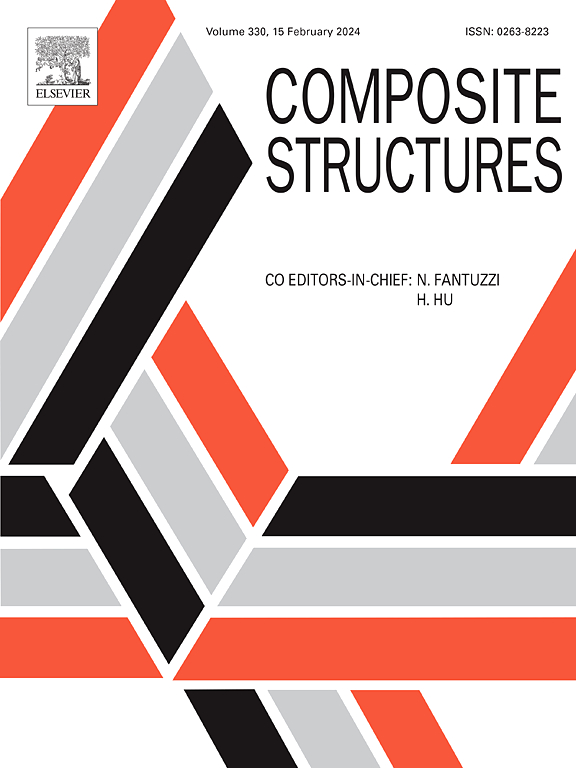Flexural properties of thin foam hybrid core sandwich panels with honeycomb cut in three-point bending: Experimental investigation and numerical analysis
IF 7.1
2区 材料科学
Q1 MATERIALS SCIENCE, COMPOSITES
引用次数: 0
Abstract
This study investigated the effects of introducing honeycomb cuts in thin foam sandwich plates on their bending properties via experiments, theoretical analyses, and FEA. Ultrathin (0.6 mm-thick) composite sandwich panels with CFRP face sheets and a core flake transfer sheet, which was a PMI foam with honeycomb cuts for better formability, were fabricated via autoclave molding. These observations indicate that the resin flowed into the cuts to form a honeycomb structure, resulting in a hybrid core sandwich panel and increased weight. A three-point bending test was performed on the sandwich beams. The cuts increased the effective bending stiffness, decreased the bending strength, and shifted the failure mode from top face sheet delamination to top face compression failure. A theoretical analysis revealed that this increase in the effective bending stiffness was caused by the addition of the resin honeycomb, which increased the shear stiffness. Furthermore, the FEA results indicated that the addition of a higher-stiffness honeycomb to the core redistributed the stress. These results show that foam cutting increases the flexural rigidity of thin sandwich panels as well as suppresses face sheet delamination and core compression while reducing flexural strength and promoting face compression failure owing to the stress concentration.

蜂窝切割泡沫复合芯芯薄板三点弯曲弯曲性能:试验研究与数值分析
通过实验、理论分析和有限元分析,研究了在泡沫夹层薄板中引入蜂窝切口对其弯曲性能的影响。超薄(0.6 mm厚)复合夹层板,CFRP面板和芯片传递板,这是一个PMI泡沫与蜂窝切割更好的成形性,通过高压灭菌成型。这些观察结果表明,树脂流入切口形成蜂窝状结构,导致混合芯夹芯板和重量增加。对夹层梁进行了三点弯曲试验。切割增加了有效抗弯刚度,降低了抗弯强度,并将破坏模式从顶板剥离转变为顶板压缩破坏。理论分析表明,有效抗弯刚度的增加是由于树脂蜂窝的加入增加了抗剪刚度。此外,有限元分析结果表明,在核心上加入更高刚度的蜂窝结构可以重新分配应力。结果表明,泡沫切割提高了薄夹层板的抗弯刚度,抑制了面板的剥离和芯层压缩,但由于应力集中,降低了面板的抗弯强度,促进了面板的压缩破坏。
本文章由计算机程序翻译,如有差异,请以英文原文为准。
求助全文
约1分钟内获得全文
求助全文
来源期刊

Composite Structures
工程技术-材料科学:复合
CiteScore
12.00
自引率
12.70%
发文量
1246
审稿时长
78 days
期刊介绍:
The past few decades have seen outstanding advances in the use of composite materials in structural applications. There can be little doubt that, within engineering circles, composites have revolutionised traditional design concepts and made possible an unparalleled range of new and exciting possibilities as viable materials for construction. Composite Structures, an International Journal, disseminates knowledge between users, manufacturers, designers and researchers involved in structures or structural components manufactured using composite materials.
The journal publishes papers which contribute to knowledge in the use of composite materials in engineering structures. Papers deal with design, research and development studies, experimental investigations, theoretical analysis and fabrication techniques relevant to the application of composites in load-bearing components for assemblies, ranging from individual components such as plates and shells to complete composite structures.
 求助内容:
求助内容: 应助结果提醒方式:
应助结果提醒方式:


